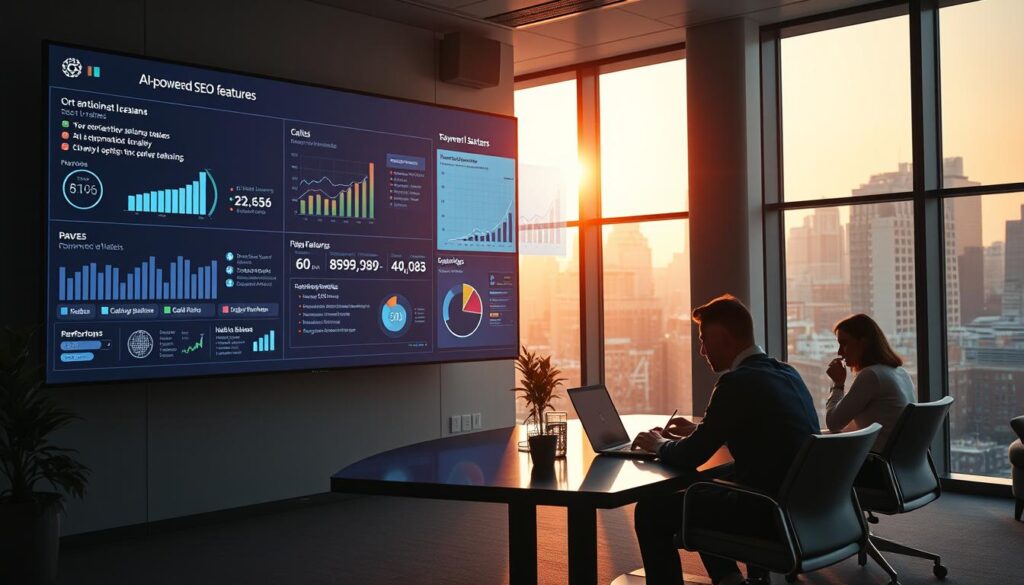The digital marketing landscape has transformed dramatically since 2019. What once relied on manual strategies now leverages automated systems to analyze data, predict trends, and refine content. Over 86% of professionals in this field now integrate advanced technologies into their workflows, according to recent industry surveys.
These innovations address challenges that previously demanded hours of human analysis. By processing vast amounts of information, they identify patterns and opportunities faster than traditional methods. Businesses report measurable improvements—65% see better campaign results after adopting these approaches.
The shift isn’t just about speed. Strategic precision has become achievable at scale, allowing teams to focus on creative solutions rather than repetitive tasks. This evolution reflects broader changes in how companies approach visibility in competitive online spaces.
Key Takeaways
- 86% of digital marketing experts use automated systems for optimization tasks
- 65% of businesses achieve better campaign outcomes with technology integration
- Modern solutions reduce manual effort through pattern recognition and data analysis
- Strategic decision-making benefits from real-time insights and predictive capabilities
- The industry shifted from human-centric processes to tech-enhanced workflows post-2019
Understanding the Rise of AI in SEO

Methods for improving search visibility shifted dramatically after 2019. What once required hours of manual analysis now leverages automated systems to identify patterns and optimize strategies. This transition reshaped how teams approach content creation, technical adjustments, and audience targeting.
Evolution of Practices Since 2019
Five years ago, professionals manually tracked keyword rankings and drafted generic blog posts. Today, machine learning algorithms process vast datasets to predict search trends and generate optimized material. Junior roles focused on repetitive tasks have been largely replaced by these intelligent systems.
Impact on Digital Marketing
These advancements enable real-time adjustments to content strategies and precise audience targeting. Predictive analytics help teams anticipate user behavior, while automated audits fix technical issues faster than human teams. Smaller businesses now compete effectively using AI-assisted methods previously available only to large corporations.
The shift extends beyond efficiency gains. It redefines success metrics in marketing, prioritizing data-driven decisions over intuition. Organizations adopting these changes report improved engagement and measurable results within competitive digital spaces.
What Are AI SEO Performance Tools?

Modern search optimization strategies increasingly rely on intelligent systems to handle complex tasks. These platforms combine pattern recognition with predictive analytics, transforming how teams approach website improvements. Unlike basic software, they adapt to algorithm changes and user behavior shifts in real time.
Defining AI-Driven Solutions
Advanced platforms merge machine learning with traditional methods to streamline workflows. They automate processes like keyword grouping, technical audits, and competitor analysis—tasks that previously required hours of manual work. For example, one platform might analyze 10,000 search queries in minutes, identifying hidden opportunities.
Key capabilities include:
- Predictive trend forecasting based on historical data patterns
- Automatic content adjustments to match search intent
- Real-time alerts for site health issues like broken links
| Feature | Traditional Methods | AI-Driven Solutions |
|---|---|---|
| Data Processing Speed | Hours/Days | Minutes |
| Keyword Discovery | Manual Research | Pattern-Based Suggestions |
| Content Optimization | Guesswork & A/B Testing | Intent-Driven Edits |
Leading platforms integrate with popular CMS platforms, creating unified dashboards for monitoring progress. Businesses using these systems report 40% faster issue resolution compared to manual approaches. The focus remains on delivering measurable improvements rather than superficial upgrades.
Exploring AI SEO performance tools: Benefits and Features

Modern solutions for enhancing online visibility now prioritize efficiency through intelligent task management. By automating routine processes, these systems free teams to concentrate on creative strategies while maintaining precision in execution.
Key capabilities include transforming how organizations handle technical improvements and content development. Metadata adjustments, internal linking patterns, and structural audits occur automatically—tasks that previously required specialized knowledge. This shift enables smaller teams to achieve enterprise-level results without extensive training.
| Task Type | Manual Approach | Automated System |
|---|---|---|
| Keyword Grouping | 4-6 hours weekly | 12 minutes |
| Content Structure | Template-Based | Intent-Driven Formatting |
| Issue Detection | Reactive Checks | Real-Time Alerts |
Predictive functionality helps anticipate search pattern shifts using historical data. Platforms learn from campaign outcomes, refining suggestions for better alignment with user needs. One enterprise reported 73% faster content deployment after implementing these systems.
Scalability remains crucial for growing organizations. Centralized dashboards manage multiple projects simultaneously, providing unified progress tracking. This adaptability ensures consistent quality whether handling single sites or complex networks.
Key Features of AI-Driven SEO Tools

Modern approaches to search visibility combine precision with scalability through intelligent data processing. These systems transform workflows by identifying patterns across vast datasets while automating routine tasks.
Enhanced Keyword Research and Analysis
Advanced platforms analyze search intent and competition levels to suggest viable terms. For instance, strategic keyword selection now considers website authority and ranking difficulty. Tools examine semantic relationships between queries, creating clusters that guide comprehensive content strategies.
| Task | Manual Process | Automated Solution |
|---|---|---|
| Keyword Grouping | 4+ hours weekly | Instant clustering |
| Competitor Analysis | Spreadsheet tracking | Real-time gap detection |
| Search Intent Mapping | Manual surveys | Behavior pattern analysis |
Automation of Technical Optimization
Systems continuously monitor site health metrics like load speeds and broken links. One enterprise reduced crawl errors by 68% using advanced automation capabilities. Real-time adjustments to metadata and internal linking occur without human intervention.
These features enable teams to focus on creative strategy rather than repetitive fixes. Predictive models prioritize high-impact improvements, ensuring resources align with measurable outcomes.
Comparative Overview of Top AI SEO Tools
The market for optimization platforms offers diverse solutions tailored to different organizational needs. Decision-makers must weigh specialized capabilities against budget constraints and team requirements.
Semrush and Its Comprehensive Features
Semrush’s $99/month package provides cross-platform brand tracking across emerging technologies like Gemini and Perplexity. Its 14-day trial allows teams to test visibility analytics before committing. The toolkit identifies content gaps by comparing strategies against competitors’ approaches.
Alternative Solutions With Distinct Advantages
Search Atlas matches Semrush’s entry price but includes five site projects and two user seats. Ahrefs charges $129 monthly for five projects but omits trial access. Writesonic emerges as a budget-friendly option at $49/month, though limited to single-project management.
| Platform | Monthly Cost | User Seats | Projects | Trial Period |
|---|---|---|---|---|
| Semrush | $99 | 1 | 1 domain | 14 days |
| Search Atlas | $99 | 2 | 5 | 7 days |
| Ahrefs | $129 | 1 | 5 | None |
| Writesonic | $49 | 1 | 1 | 7 days |
“Scalability becomes critical when selecting platforms—enterprise teams need different capabilities than solo consultants.”
Pricing structures reflect target audiences more than technical superiority. Multi-user teams might prioritize Search Atlas, while agencies could prefer Ahrefs’ project capacity. Trial availability helps assess long-term value before scaling commitments.
Real-World Success Stories Using AI Tools
Organizations across industries now achieve measurable outcomes by merging human expertise with automated systems. A travel platform increased organic traffic by 150% within six months using machine-generated articles refined by editors. Their process involved identifying underserved topics through advanced pattern recognition in keyword clustering, then producing draft materials for strategic enhancement.
Case studies reveal surprising effectiveness when automated drafts undergo human curation. One e-commerce site reported 80% faster article production while maintaining engagement metrics comparable to manually written pieces. The key lay in balancing automation with editorial oversight—materials underwent fact-checking and brand voice alignment before publication.
Financial service providers demonstrate how data-driven approaches uncover hidden opportunities. By analyzing search patterns across 12 markets, teams identified niche queries driving 35% of their qualified leads. This approach reduced content gaps by 62% compared to traditional research methods.
Effective implementations often combine multiple specialized platforms. For example, marketing agencies use multi-platform integration strategies to handle keyword analysis, content structuring, and performance tracking simultaneously. One team cut campaign development time from three weeks to five days through this coordinated workflow.
“Automated drafts form the foundation—our editors transform them into polished assets that resonate with both algorithms and readers.”
These successes highlight critical best practices: rigorous quality control, continuous performance monitoring, and strategic resource allocation. Organizations treating machine-generated materials as raw inputs rather than final products consistently outperform competitors in search visibility metrics.
Integrating AI Tools into Your SEO Strategy
Adopting advanced technologies requires careful alignment with existing workflows. Teams must balance automation capabilities with human expertise to maintain quality standards while improving efficiency. This approach ensures technological enhancements complement rather than disrupt established processes.
Phased Implementation Framework
Begin by auditing current website performance and content pipelines. Identify repetitive tasks like metadata updates or broken link detection where automation delivers immediate value. Gradually introduce tools that integrate with existing platforms to minimize learning curves.
For content development, use generated drafts as foundations for refinement. Professionals should edit for brand voice accuracy and verify factual claims. Platforms offering customizable prompts help maintain editorial standards while accelerating production.
Maintaining Strategic Oversight
Establish review checkpoints for all automated outputs. Technical changes like redirect implementations require pre-approval protocols to prevent site structure issues. Regularly assess whether tool-generated recommendations align with broader business objectives.
Successful integration hinges on viewing technology as collaborative partners rather than replacements. Teams that combine machine efficiency with human judgment achieve sustainable improvements in search visibility and audience engagement.







